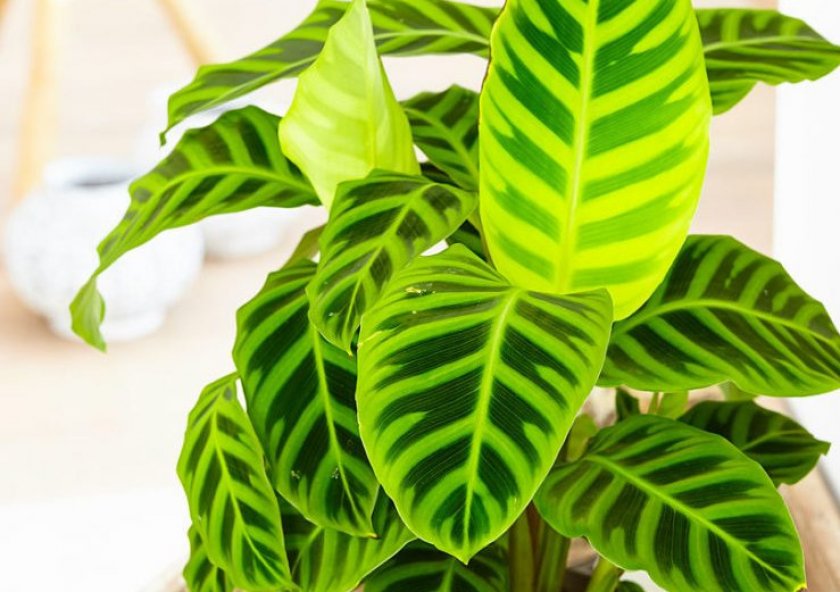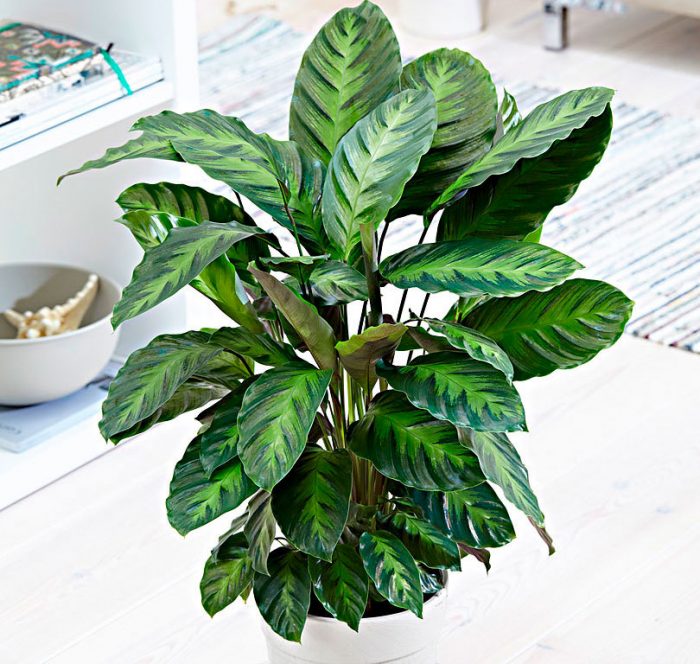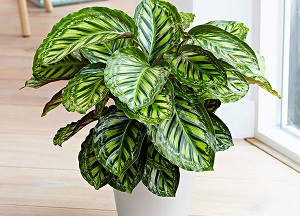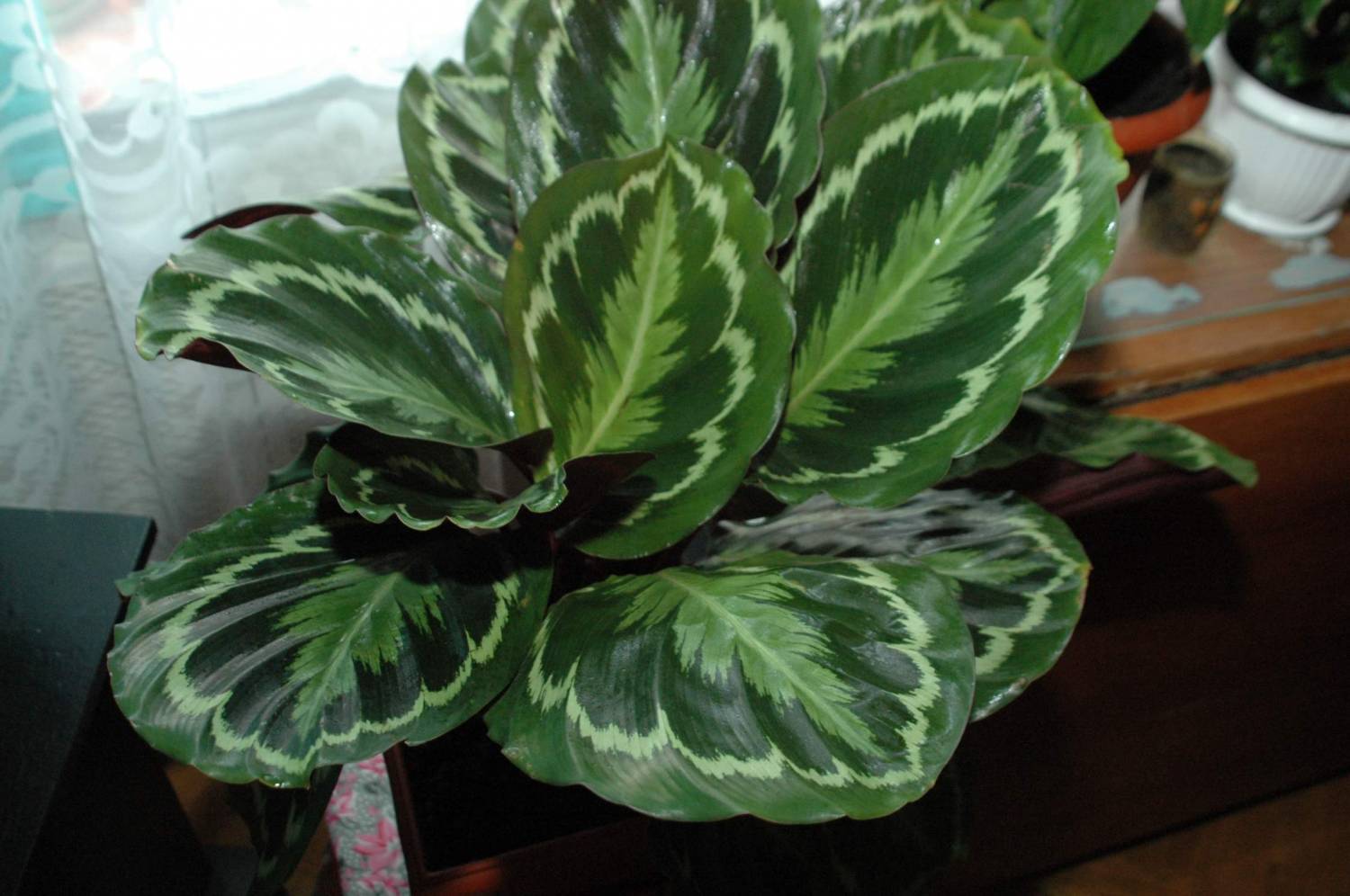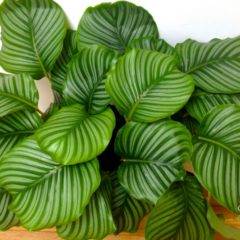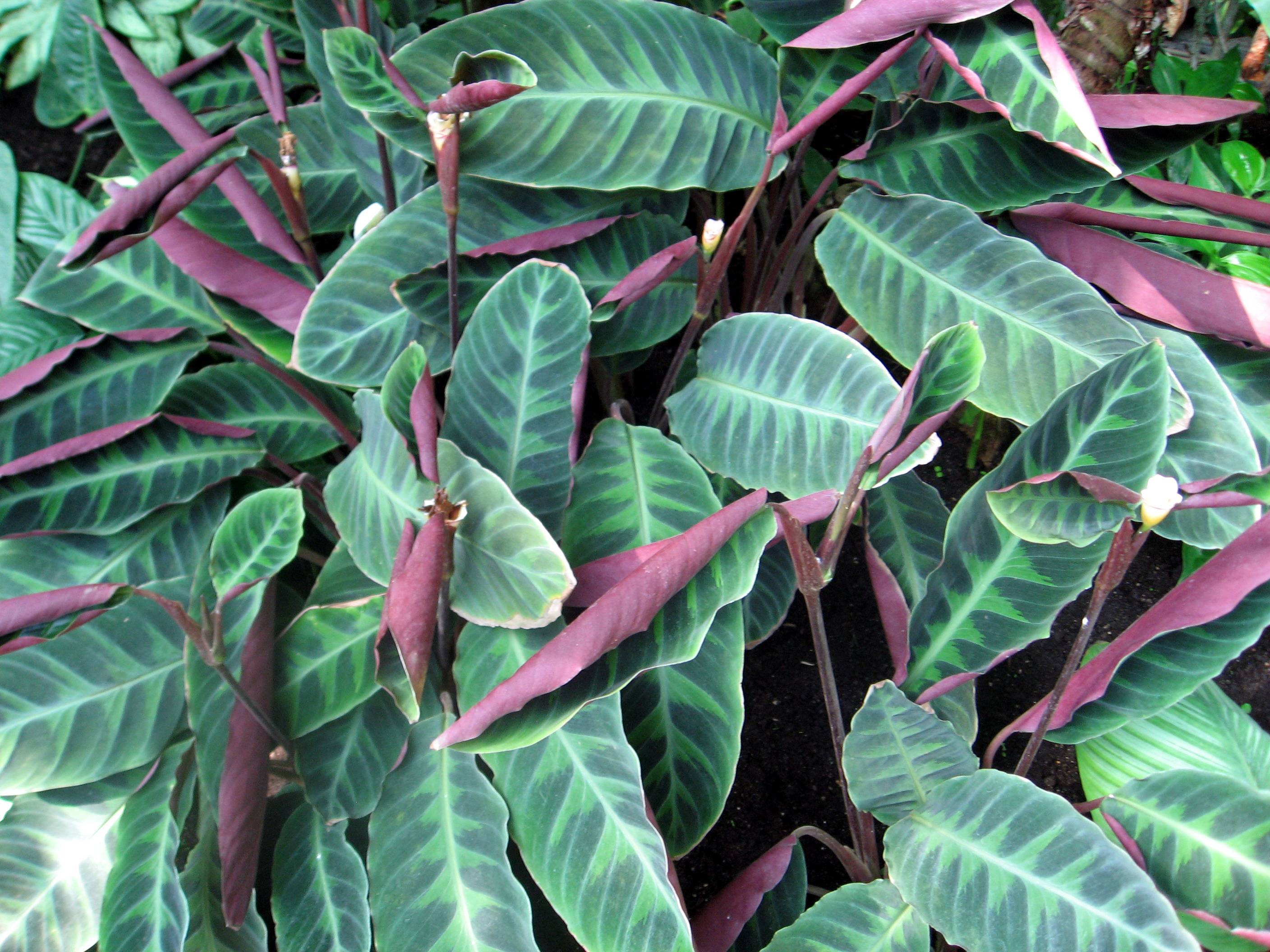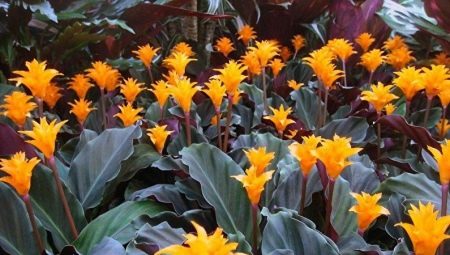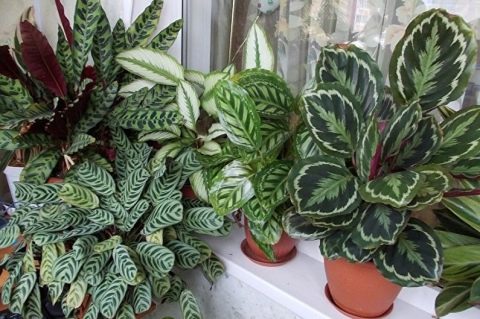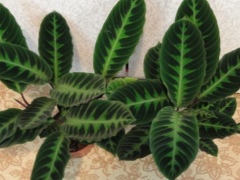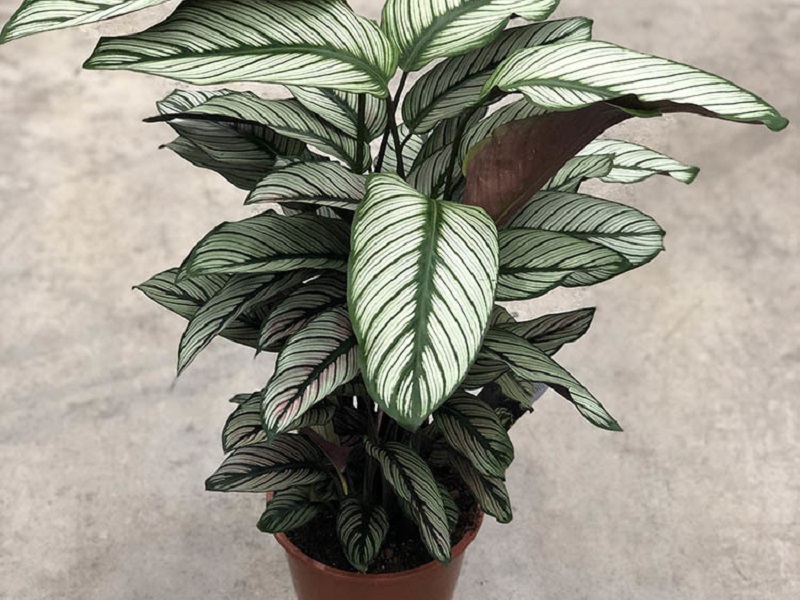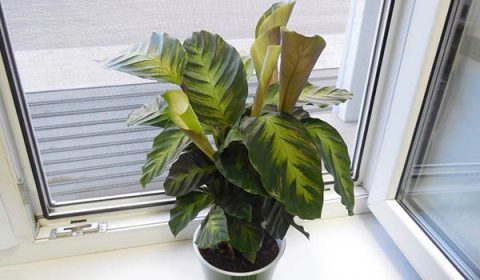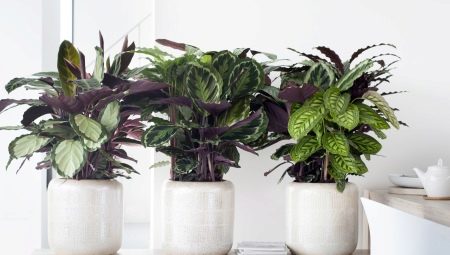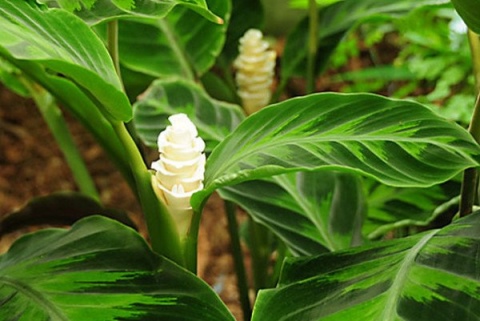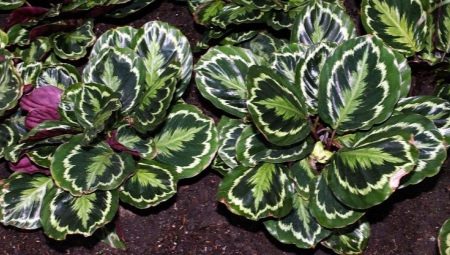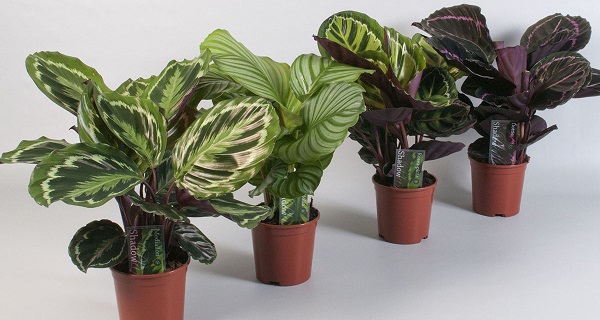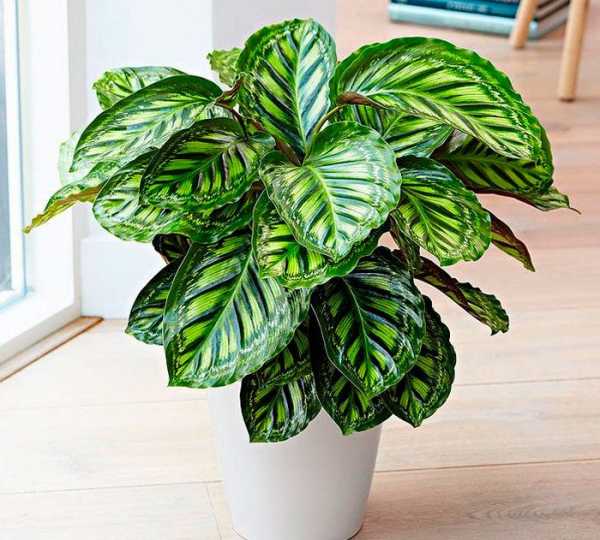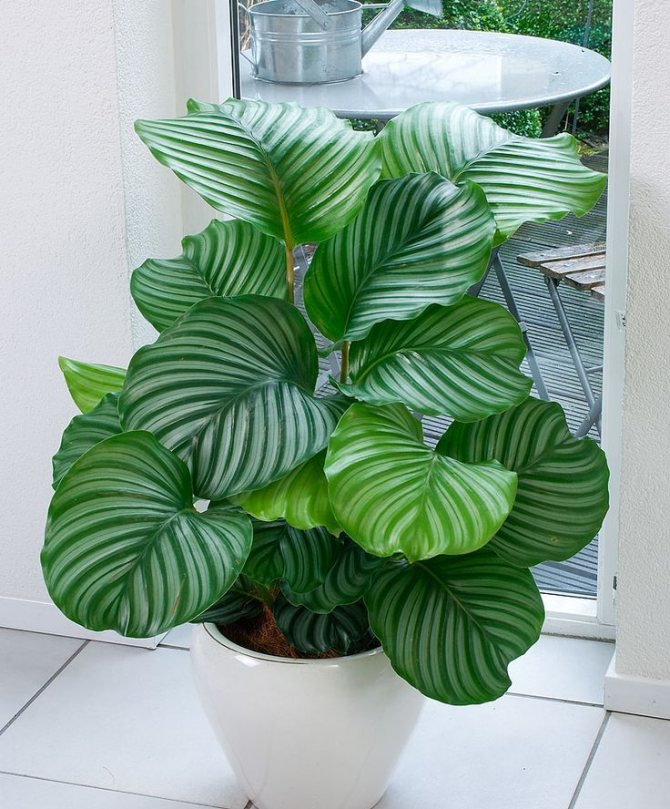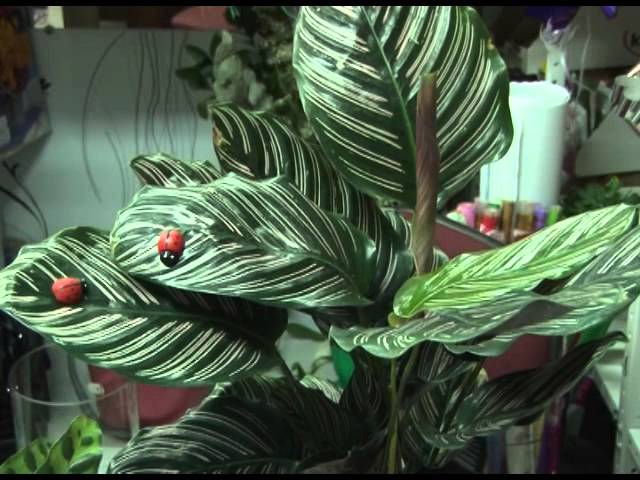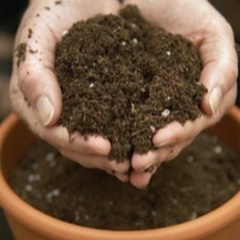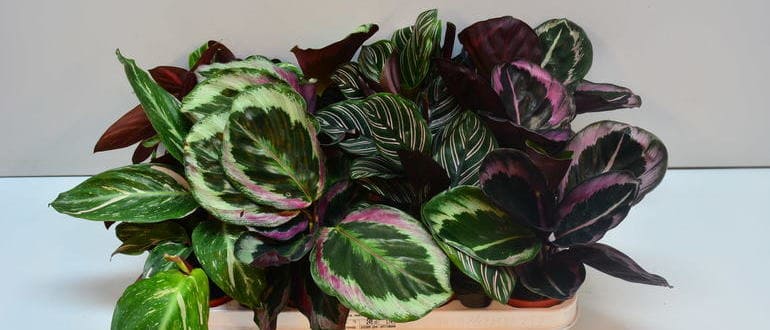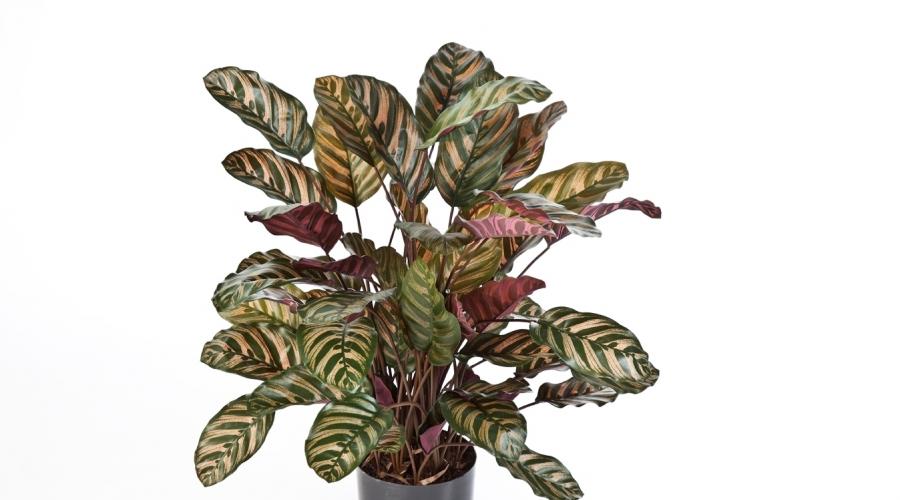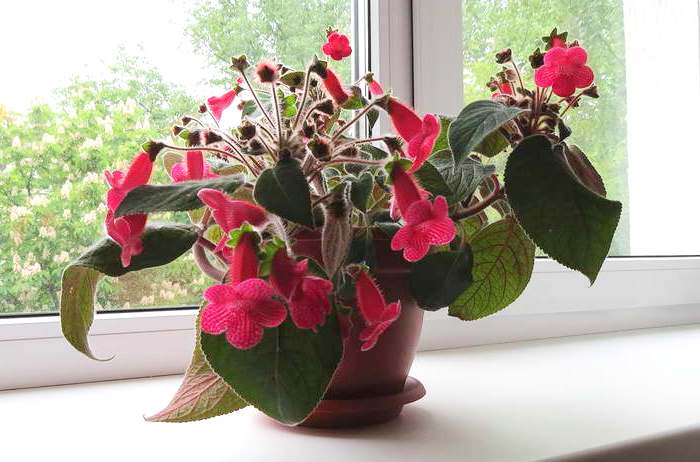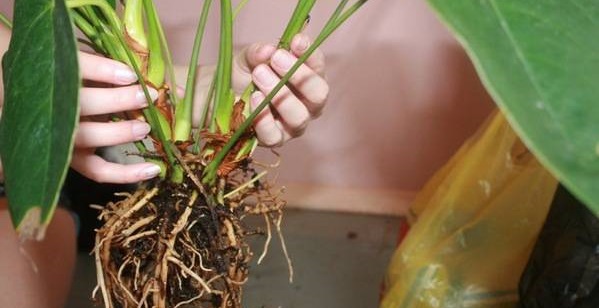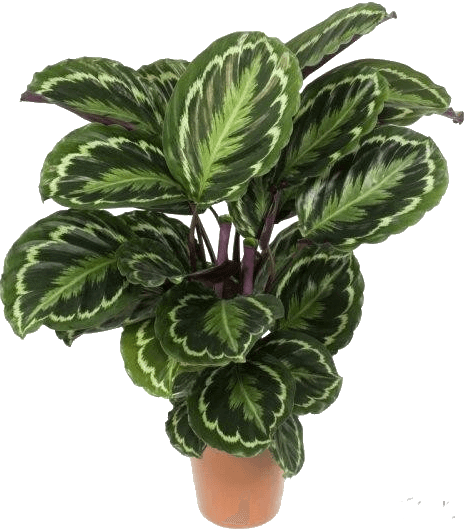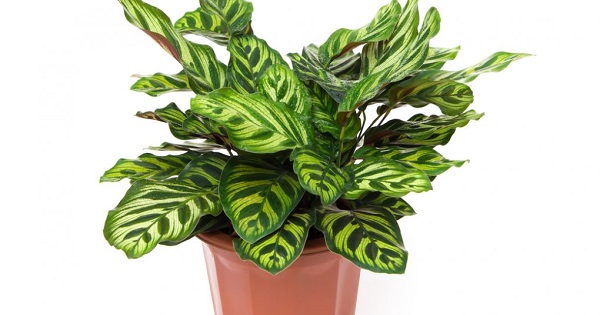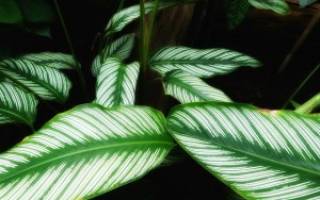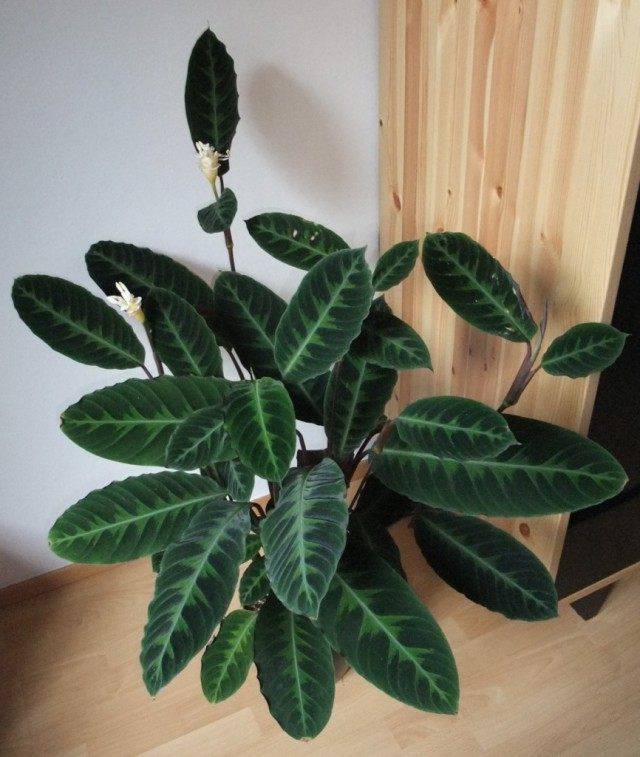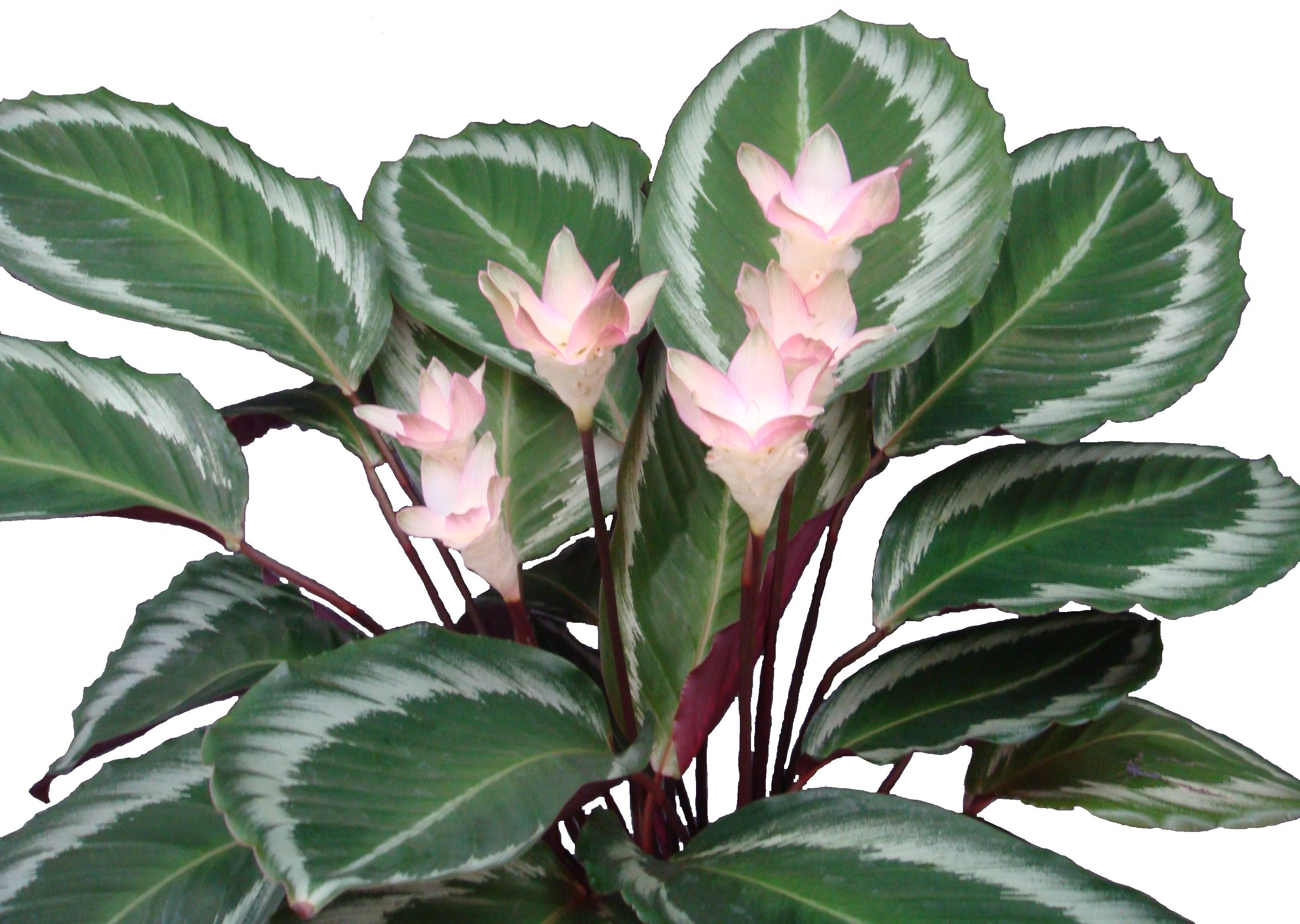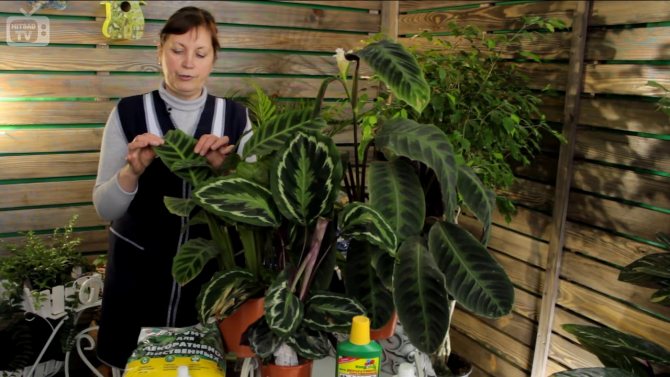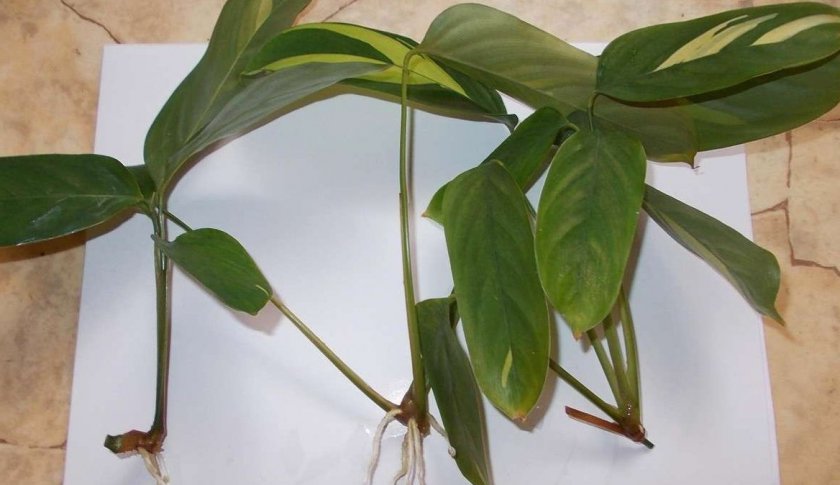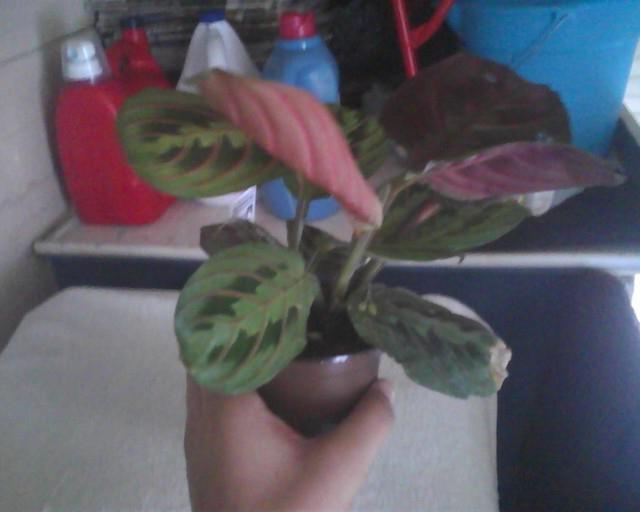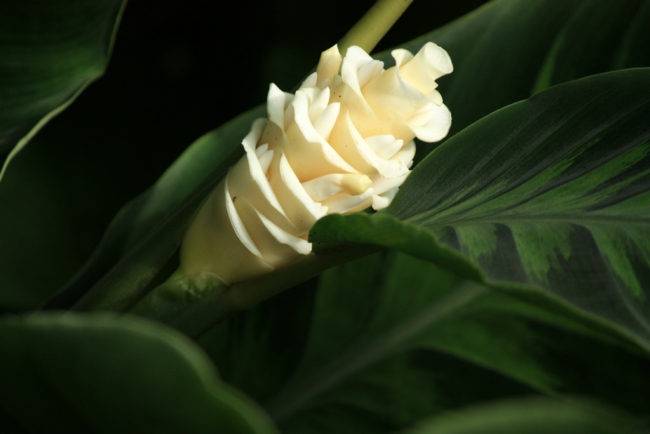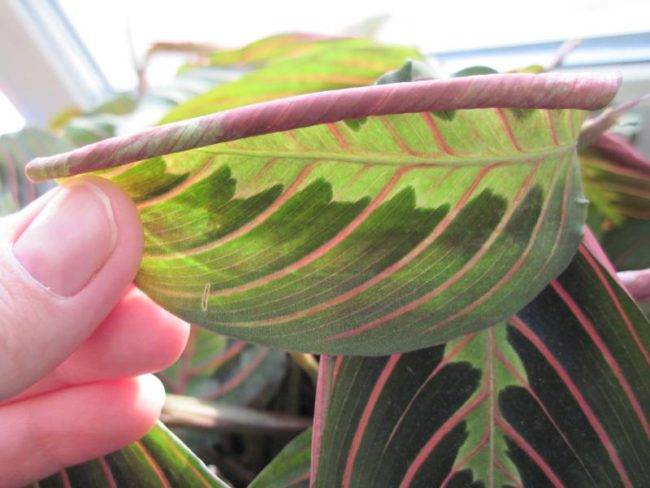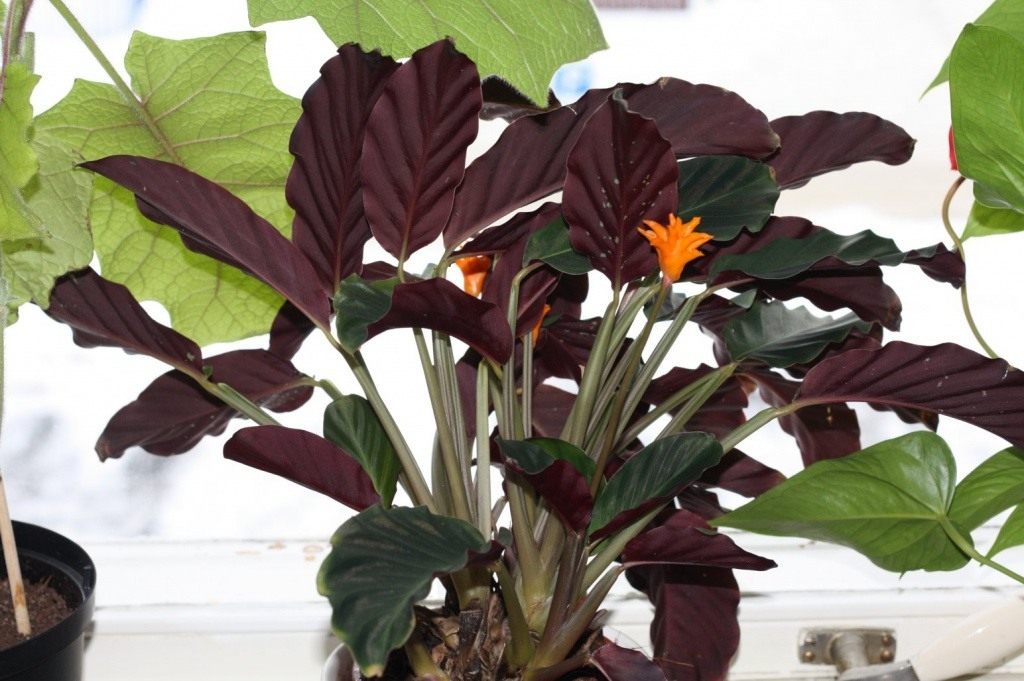Plant transplant after purchase and as it grows
The optimal time for transplanting calathea is early spring. This procedure is vital for the plant. But do not transplant calathea at the wrong time. Therefore, new items for your collection should be bought at the end of winter or at the beginning of spring. Plants aged 1 to 3 years are transplanted annually, then every 2-3 years (depending on the state of the flower).
Before starting a transplant, you need to take care of a suitable soil and pot. Purchase a special soil mixture designed for plants from the arrowroot family. If not, soil for growing azaleas or rhododendrons is suitable. Experienced growers prefer to prepare the soil on their own, mixing in a 2: 1: 1: 1 ratio of fertile soil from their own garden, humus, peat and coarse river sand. Another option is to mix earth, humus and peat in equal proportions. A prerequisite is a slightly acidic or neutral indicator of the acid-base balance. At the same time, only wood ash can be deoxidized.
The pot for calathea should be low, but wide and resemble a bowl in shape. This is due to the fact that the root system comes very close to the surface. As for the material, it is better to give preference to unglazed ceramics. This will provide oxygen access to the roots in the required volume.
The most suitable pot for calathea is similar to a basin or a bowl.
The transplant takes place as follows:
When preparing for transplanting, water the plant abundantly in 1–1.5 hours. This will make it much easier to remove from the old pot.
Before filling the pot with soil, take care of the drainage. The layer thickness must be at least a quarter of the container height. Expanded clay, river pebbles, small gravel, brick chips, small ceramic shards and even eggshells can be used as drainage. It is useful to sprinkle the drain with a thin layer of powdered charcoal or activated carbon. This is an additional prevention of root rot.
Drainage can be filled with soil. The layer thickness should not exceed 2-3 cm
You do not need to tamp it.
Remove the calathea carefully from the old pot to avoid damaging the roots. No need to try to pull out one plant - take out the entire earthy clod.
Rinse the roots under running cool water and carefully examine
All roots with traces of rot, mold and other damage must be cut with a sharp knife strictly perpendicular. The cut sites are disinfected with a pink solution of potassium permanganate and covered with crushed charcoal or sifted wood ash. Also trim off any old dry leaves.
Place the plant on the soil. Spread the roots gently. Be sure to hold the calathea with your hand, constantly making sure that the growing point is above the surface of the substrate and does not move away from the center of the pot.
The soil is poured into the pot carefully, in small portions, stopping when 1.5–2 cm remains to the upper edge of the pot. It is slightly crushed, but not tamped. The roots left without air are the inevitable speedy death of Calathea.
Then the transplanted calathea is watered abundantly and removed for 2-3 days in a cool place, protected from direct sunlight. This is necessary to minimize the consequences of the transplant.
Transplant and reproduction of calathea
Young Calathea plants are transplanted annually in February-March. The roots painfully tolerate the transplant, so the calathea is simply transferred into a new container, without disturbing the clod of earth on the roots of the plant. For transshipment, wide, shallow pots are used, which is associated with the superficial root system of plants.When planting, the rhizome is placed strictly vertically in the center of the pot and a new substrate is added around. The soil in the pot is only slightly compacted around the planted plant.
This planting is necessary to maintain the air permeability of the soil. Otherwise, in a dense substrate, the roots of the calathea will suffocate and the plant will die. Adult plants are transferred to a new container less often, once every 2-4 years. The approximate transplantation time is determined by the appearance of roots from the drainage hole of the pot. When transplanting, it is necessary to install a drainage layer of shards, large pebbles at the bottom of the pot.
Simultaneously with the transplantation in adult plants, the formed processes with 2-3 roots and several leaves are separated. Young plants are planted in a prepared container and create greenhouse conditions by covering the new planting with glass containers or a plastic bag to maintain high humidity and constant temperature. In a simulated greenhouse, the temperature fluctuates between +23 .. +24 ºС.
The second method of vegetative propagation is dividing the rhizome into 2 parts. Slices are sprinkled with activated carbon. The rest of the steps are the same as for the transfer.
Caring for room calathea at home
Calathea is quite difficult to grow in culture. In the skillful hands of experienced florists, they will grow simply in a pot, but it is much easier to grow them in a florarium.
Indoor calatheas develop well in diffused light. In winter, it is advisable to additionally illuminate the plants. They do not tolerate direct sunlight during the spring and summer months. The size and color of the leaves depends on how well the plant is protected from the sun. In very bright light, the leaves lose their color and become smaller.
When caring for calathea at home, it is necessary to ensure certain temperature conditions. Plants do not tolerate cold drafts and require temperatures not lower than 18 ° C in winter. In the spring-summer period during the day, the optimum temperature should be 22-30 ° C, at night it can be slightly cooler. A sudden change in temperature can be detrimental to the most delicate varieties, the leaves become lethargic and rot.
Calathea is very demanding for watering, especially in the summer. In addition, the plant needs high air humidity. Water abundantly in summer. Well-settled or filtered water is regularly sprayed with a fine spray, since large drops of water should not fall on the leaves - dark spots may appear on them. Species with soft velvety leaves are not sprayed or wiped off - they create a humid environment in the pallet of moss, pebbles or expanded clay, flooded with water. The bottom of the pot should not touch the water.
In winter, watering is reduced. Dry air causes yellowing, drying and curdling of leaves, with excess moisture, the roots rot. If you do not adjust the watering mode, then the calathea can completely shed the leaves. Calathea Makoi is especially sensitive to waterlogging of the soil substrate.
During the period of active growth, the plants are fed once every two weeks with a weak (0.5% or less of the norm) solution of mineral fertilizers with a low calcium content. Fertilizers for flowering plants are used for saffron calathea.
Young calatheas are transplanted annually, adults - every two years in late spring or summer. When transplanting, old dying leaves are removed. Choose a shallow pot for plants. The soil should be nutritious, loose and permeable, slightly acidic (pH up to 6). The optimal soil mixture is prepared from leaf and humus soil, peat and sand (1: 1: 1: 0.5). Good drainage is required (up to 1/4 of the pot height).
How to take care of Calathea?
In order for calathea to please you with its beautiful appearance, you need to follow a number of rules and features when leaving it. The most important point is the choice of the place where the inflorescence will be located.
Placement and lighting of the flower
The ideal option for placing a calathea is a place where there is enough light, but there is no direct sunlight. The most comfortable and suitable options for growing are windows that face west or east. It is necessary to take into account the moment that with a lack of light, the plant will deteriorate and stop growing altogether.
Temperature
The best option for growing will be a temperature of 20 - 25 degrees. Calathea can also tolerate high temperatures, however, with a stable air humidity.
In winter conditions, the temperature regime should be 16 - 17 degrees. Drafts and pressure surges are undesirable for calathea.
Air humidity
The main factor in the cultivation of calathea is air humidity. A sprayer can be used to maintain stable moisture. Spraying the air around the flower is also allowed. It is not recommended to spray the leaves of the inflorescence, they can only be wiped with a damp cloth occasionally. The most correct and practical option for a plant is to grow it in an aquarium.
Sand is poured into the aquarium so that it maintains the necessary moisture. Due to such conditions, the flower will receive the required temperature, moisture, and will be protected from intense drafts.
Watering
 watering (pictured) is carried out every 3 days
watering (pictured) is carried out every 3 days
The stability of irrigation primarily depends on the temperature regime. On hot days, watering (pictured) is carried out every 3 days. In no case should moisture be allowed to remain in the pan of the pot; after watering, it must be drained. If this procedure is not done on time, the roots will begin to disappear. When watering, the water should be slightly warmer than room water.
The soil
The soil for calathea must be saturated with oxygen; to reduce its density, it is necessary to add special fertilizers. These types of fertilizers most often include sand, humus, peat.
The soil must be loose, saturated with fertilizers, rich in useful elements, in order for the inflorescence to develop and grow in conditions suitable for it.
Plant transplant
Young calatheas require an annual transplant, adults can be transplanted every 2 to 3 years. It is advisable to transplant calathea in the spring. The pot is not needed large, but wide.
After purchase, any type of plant must be transplanted:
- before replanting, you must choose a pot. An excellent option would be large containers, but not deep in shape, so that the calathea develops well;
- The roots should not touch the drainage, otherwise the calathea will start to rot and disappear. Most often, ready-made soil is used for transplanting;
- When transplanting, the root should be in the middle of the pot. Before transplanting, the roots are straightened a little, they are sprinkled not very densely so that the earth allows air to pass through;
- After transplanting, they are treated with the necessary biological additives, watered well so that the flower is saturated with moisture. An obligatory point is that the water must be filtered.
Fertilizer Calathea
Plants are fertilized so that they are saturated with nutrients and they grow comfortably. Fertilizing is advised with additives from organic nutrients.
During the flowering period of Calathea, fertilizer is applied every fourteen days. You need to approach feeding rationally, not exaggerate or underestimate.
If the feeding is not correct, then the flowers of the leaves will begin to lose their appearance.
Caring for calathea at home
Calathea is very beautiful, but capricious in care and can be recommended for growing by experienced florists. In nature, it grows in moist and warm forests, under the crowns of trees, sometimes on highly moist, swampy soils, along the banks of water bodies. In the house, she will feel as comfortable as you create conditions for her that are close to natural.
Adherence to shade is a very valuable quality, as few houseplants put up with it. Therefore, calathea can be used to plant trees in the far darkened corners of the dwelling and to carry out gardening of the interior, and not just the windowsills. Perhaps, in some cases, the optimal place for a plant is the kitchen, where they often boil and steam. The air here is always warm both in winter and in summer. Regular spraying of the plant, plus the steam coming from the stove, saturates the air with the necessary moisture.
Soil requirements
Calathea loves slightly acidic soil, which is based on leafy and humus soil, peat and sand in a ratio of 1: 1: 1: 0.5. The soil must be well breathable and moisture-absorbing, it must necessarily have drainage so that there is no stagnation of water, expanded clay is an excellent material for this.
You can use a ready-made store-bought substrate for rhododendrons or arrowroots.
Transfer after purchase
While the plant is young, it is transplanted every year, it is best to do this in the spring. More mature plants are transplanted once every 2-3 years. For transplanting, take a larger pot, but not high, since the roots do not grow deep. Be sure to make a good drainage layer.
When transplanting, they completely transfer the earthen lump, trying not to destroy it and not damage the roots of the plant. Then fill the voids in the pot with fresh earthen substrate.
Top dressing calathea
In the growing season from April to August, calathea is fed with liquid complex fertilizer for indoor decorative leafy plants every two weeks, and flowering species such as saffron and crocat are fed with fertilizer for flowering indoor plants.
It can be recommended during the period of intensive growth, from spring to autumn, to feed it with liquid vermicompost every 2-3 weeks. The main thing is not to overdo it, calatheas are sensitive to excess or overfeeding of fertilizers.
Plant lighting
The Tropican woman feels best on the bright, warm south-west and south-east windows. With a lack of illumination, the color of the leaves is lost, becoming uniformly green, the spots merge against the general background of the leaf.
In intense sunlight, on the contrary, the leaves turn brown-red, burns appear, and the leaves themselves can curl into a tube and fall off, therefore, direct sunlight is contraindicated for it.
Temperature
Heat-loving calathea tolerates temperatures up to +30 degrees in summer, subject to high humidity, but the optimal temperature is not lower than 20 ° (preferably 22-24). In winter, the temperature in the room should be moderate - not lower than 16-19 ° C. A sudden change in temperature and cold draft can be detrimental to the most delicate varieties, the leaves become lethargic and rot.
Watering calathea
Calathea is a big lover of water. In summer, you need to drink it at least 2-3 times a week with warm soft water, in winter, once a week is enough. If you have tap water, it must be defended for at least 12 hours at room temperature. The plant needs moist air, regular spraying with warm water. Leaves are periodically wiped with a sponge - especially those types of kalata that have hard glossy leaves, varieties with thin, velvety leaves are best not wiped off, but they need humid air no less.
The pot can be placed in moist peat or kept in a terrarium. You can also recommend putting the pot with calathea on a tray with damp pebbles in the summer (while you need to make sure that the bottom of the pot does not touch the water) or peat. And one more piece of advice: try to avoid both overmoistening of the earthen coma and overdrying it. Indeed, in both cases, the capricious variegated beauty will declare her protest - she can fold and shed the leaves.
Rules for caring for calathea at home
Calathea belongs to the arrowroot family. Under natural conditions, this plant can be found in the humid tropics of Africa and Central America.Calathea, like other representatives of the arrowroot family, such as, for example, ktenant, stromant, arrowroot is appreciated by flower growers, primarily for the beautiful color of the leaves. These plants have a characteristic pattern on the surface of their leaves, in most cases it is an alternation of light and dark stripes.
Calathea prefers shaded areas and in nature prefers to grow in the shade of other plants. With the onset of day, the leaves of this plant open, and with the onset of darkness, they fold back. This plant has retained its natural rhythm at home. Calathea, home care that requires special attention, is grown as an ornamental deciduous plant, but there are also species that have spike-shaped flowers.
The leaves of the calathea are oval, petiolate, rather large, and have a length of 18-27 centimeters. On their surface, white and silver stripes alternate, and in other species of calathea, stripes and spots of red-brown and yellow can be observed on the leaves. The leaves of the plant are mobile and constantly turn in the direction of the light source. The flowers are of different colors and are collected in small spikelets. Some calathea species have very attractive and beautiful flowers.
Calathea is not easy and home care for which has many nuances is a very capricious plant. When grown at home, it does not tolerate drafts, dry air, overdried soil. If the place is chosen correctly for the growth of the calathea and the appropriate care is provided, then this flower will delight its owners with lush and extremely beautiful leaves. Just like other plants of the arrowroot family, calathea should not be placed close to heating devices, since the dry air emanating from them can quickly destroy its beautiful leaves.
Calathea crocata, also known as saffron calathea. This plant has wavy, oval leaves, dark green above and brown below. The flowers are placed on tall peduncles and are orange-red in color. In order for Calathea crocata to bloom, it should be kept in a shaded meta between December and December. The plant usually blooms in the middle of winter.
Calathea Varshevich has leaves of a dark green color with a light pattern, and they are dark red below. Flowers are creamy, white or pink, usually clustered in an inflorescence in the form of a spikelet.
Calathea Makoya. The leaves of this plant have long petioles and are covered with dark and light stripes. There are wonderful burgundy patterns on the underside of the leaves.
Calathea medallion. It is a compact houseplant that has broad, deep green leaves with pink stripes extending from the midrib. Over time, this pattern begins to lighten. The reverse side of the leaves of this plant is dark pink in color. This plant is quite compact and takes up very little space.
Calathea is zebra-shaped or striped. Its appearance resembles a medallion calathea, but, nevertheless, its leaves are significantly elongated, and its stripes are bright green on the dark green surface of the leaf plate. The underside of the leaves is red-purple.
Painted calathea has oblong leaves up to 25 centimeters long. A wonderful combination of dark and pale green leaf color: on the upper side there is a light middle with symmetrical stripes and a dark green stripe along the edges of the leaves.
Decorated calathea. It is a short houseplant that has narrow leaves. The leaves are dark green in color, with white and pink stripes along the lateral veins and burgundy on the underside of the leaf.
Calathea lanceolate or Calathea wonderful is an unpretentious plant that has long leaves that are covered with dark green oval patterns on a light green surface. Below the leaves are purple in color.
Why do Calathea leaves turn yellow and dry
Possible problems and methods of their elimination are presented in the table.
| Problem | Possible reason | How to fix |
|---|---|---|
| Leaves dry and curl | 1.Lack of moisture in the air. 2. Drafts. | 1. Moisten the air with a spray bottle. 2. Move the plant to another location. |
| Leaves dry and darken | 1. There is not enough moisture in the air. 2. Drafts. | 1. Moisten the air with a spray bottle. 2. Move the plant to another location. |
| The tips of the leaves dry out and turn brown. | The presence of dry air. | Moisture is required in any suitable manner. |
| The leaves turn yellow and dry. | 1. There is not enough warmth in the room. 2. Excess or lack of moisture in the soil. 3. Excess fertilizer. | Analyze your actions to figure out how to fix things. |
| The leaves are stretched out, thinned | Not enough lighting. | Find a lighter spot. Breakage can be avoided by using props and tying. |
| The leaves are covered with yellow spots. | Direct sunlight falls. | Place the pot in partial shade. |
| There are dark spots on the leaves. | There is excess moisture in the air. | Stop spraying for a while. |
| The stems are taken out and rot. | Cold air. Excessive humidity. | Bring the microclimate back to normal. |
| The leaves fall off. | Waterlogged or dry soil. | Check out the clod of earth. |
The pests of calathea can also become the cause of the described ailments.

